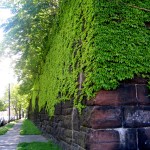
Concept design by Cassandra Wilday Associates. Cassandra Wilday, Demetri Sarantitis, Jason Gould. Commissioned by Embankment Preservation Coalition
The Harsimus Stem Embankment is a massive stone structure that once supported seven tracks of the old Pennsylvania Railroad. The Embankment Preservation Coalition has been working for almost 15 years towards a goal of transforming the Embankment into a nature habitat and park. This structure is particularly interesting and historically important for the role it played in connecting the Pennsylvania Railroad — the largest and most powerful railroad in America — with the Hudson River.
The freight trains of “the Pennsy,” as it was known, traveled down the Harsimus Stem Embankment to a rail yard on the Hudson River waterfront, where goods contained in railroad box cars were transferred to special barges called “lighters” (because they lightened the load of the trains) or “car floats” and floated across the river to freight warehouses in Brooklyn and Manhattan. This “lighterage system” was a major part of the transportation network and was essential for the delivery of freight from the western states of the country to New York.
It’s hard to imagine it today, but one hundred years ago the Hudson River was filled with car floats that were pushed along by tugboats. Because this was before the days of radio, each tugboat had its own individual steam whistle, and the boats communicated by a system of code signals. At one time there were as many as 750 tugboats in New York Harbor, and they moved between 3,000 – 5,000 barges a day. According to one source, “the harbor looked and sounded like a traffic jam in midtown Manhattan.” The writer Phillip Lopate, in his excellent book Waterfront: A Walk Around Manhattan, observed that “In their heydey, the barges were almost as synonymous with New York’s iconography as its skyscrapers.”
The Harsimus Stem Embankment project is exciting for the historical context it provides and also for the ideas that the Coalition has put forward as part of the design process. The concept for the park they envision includes a habitat strip reserved for the possible development of light rail in the future, a biking and walking trail, and an outdoor classroom and nature center with environmental toilets (composting or incinerating), birdhouse meadow and woods. They’re committed to creating a sustainable landscape and preserving a sense of wildness in the middle of this urban area.
Jenny Meyer of the Embankment Preservation Coalition kindly provided images of the architectural concepts as well as photos of the park as it appears today. The massive stone structure — at 27 feet above street level it’s just a few feet lower than the High Line — is a visual reminder of the powerful role that railroads played in the 19th and 20th centuries. In the many decades since the trains stopped running, Nature has taken over the Embankment; see the tall trees in the photo at the left (you can click to enlarge it) and the beautiful grasses in the one below.
Today, in the 21st century, we can imagine this infrastructure of a bygone industrial age turned into public space that offers the opportunity for enjoyment and education to all.
To learn more about the Harsimus Stem Embankment visit the Coalition’s website.
For a 2011 year-end update from the Embankment Preservation Coalition, click here.
Read about other Urban Greenways.











